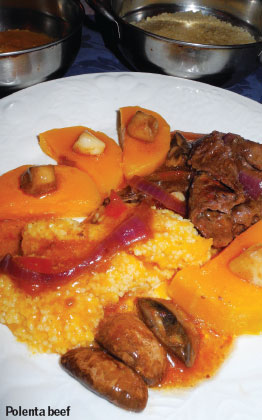Semolina makes many dishes; Griessbrei, Kasari, Soonji, Pudding, Gnocchi and Polenta
Updated: 2013-12-06 06:40
By Maggie Beale(HK Edition)
|
|||||||||
A coarse pale-yellow flour, semolina is ground from hard durum wheat. It is traditionally used to make pasta, pizza, bread and biscuit dough as well as polenta and gnocchi, staples of Mediterranean cuisines.
Semolina is also made into a British pudding so well beloved of school dinners in the UK, and for the Indian sweet desserts called Kesari or Sooji semolina can be served with pineapple or cashew nuts. In Germany, the pudding dish is known as Griessbrei and served with anything from applesauce to ground cinnamon and sugar.
In all of the sweet/dessert recipes where this versatile grain becomes a pudding, the semolina is cooked in milk and sweetened with sugar or honey. And as a quick nutritional meal fix, it is served topped with nothing more than a spoonful of honey, jam or fresh or dried fruit.
But semolina has a special place in the savoury dish category - perhaps best of all during the festive season - such as Italian polenta to accompany a wild boar stew. And for gnocchi; wonderful little oven-baked parcels filled or topped with cheese that are just right to serve with a glass of light red or a ros wine.
In a large pot over medium-high heat, bring 4 cups of milk to a simmer. Reduce heat to low and slowly whisk in 8 ozs (1 cups) semolina. Keep whisking and cook for 8-10 minutes. With the addition of salt and pepper - and some spices - this is now the base for polenta or gnocchi.
Gnocchi: Stir briskly as you add cup grated Parmesan cheese to the cooked semolina plus 4 tbsp butter, a pinch of grated nutmeg and 1 egg yolk, and season with salt. Remove from the heat. Moisten a 15" x 10" rimmed baking sheet with a tiny sprinkling of water. Pour the cooked semolina mixture onto the baking sheet and smooth out the surface with a spatula to inch high. Let it cool for about 40 minutes. Heat the oven to 230 C (450 F). Cut the semolina dough into 2" squares; transfer half of the squares to a buttered 9" x 13" baking pan. Sprinkle cup grated Parmesan cheese over the gnocchi and dot each with a little butter. Layer remaining gnocchi on top and sprinkle with cup grated cheese and 1 oz butter. Bake until golden, about 15 minutes.
Polenta is a perfect and quickly made accompaniment for sauce-rich meat dishes.
To develop a luscious earthy sweetness, venison and wild boar benefit from long, slow cooking in this Scottish recipe, so you will need a heavy casserole. For a festive dish of wild boar or venison stew with polenta, you will need 750 g (1 lb 10 oz) wild boar or venison neck or shoulder meat, chopped into 1-inch (3cm) cubes. Heat the oven to 180 C, the stovetop ring to medium low. Coat the meat pieces in seasoned flour (plain all purpose flour with a good pinch of salt and pepper), and put into the casserole along with 4 Tbsp sunflower oil, 4 Tbsp butter and 4 ozs pancetta or bacon finely chopped, and cook on the stovetop until browned - stir now and then to keep from sticking.
In the meantime, peel and finely chop 1 yellow onion, 2 carrots, 2 stalks of celery, 3 garlic cloves and add to the meat in the heavy casserole, and fry/stir for 4 minutes. Add 2 Tbsp commercially produced Red currant jelly (lucky you if you have some homemade), 4 fl ozs ( cup) of red wine such as Rioja and 8 fl ozs (1 cup) beef stock, 2 Tbsp tomato puree, a strip of orange rind (about 2 inches long), tspn fresh thyme and 2 bay leaves, put the lid on and transfer the casserole to the oven for 1 hours. If your oven is otherwise engaged - cook on the stovetop in a heavy lidded pan on low for 1 hour 15 minutes. Keep watch for sticking. Remove from the heat (oven) and check the seasoning and for doneness using a fork.
Serve the polenta with some oven-roasted garlic cloves along with the meaty stew and some lightly braised pumpkin pieces. The ideal wine for this rich dish is a Malbec from Argentina - try a high quality production such as the Finca Flichman from Mendoza. The same house also makes a very smooth, silky ros to serve as an aperitif or with the gnocchi. Until now, ros wine has not been very popular here in Hong Kong, except in connoisseurs' circles, but recent releases of more deeply colored ros wines from South America is seeing a surge in appreciation. For best results chill the wine bottle before opening down to about 12 or 13 degrees C, use an ice bucket - or even a large pan - half filled with cold water and ice. It should take about 30 minutes or so.

(HK Edition 12/06/2013 page7)